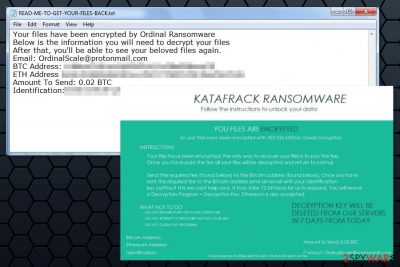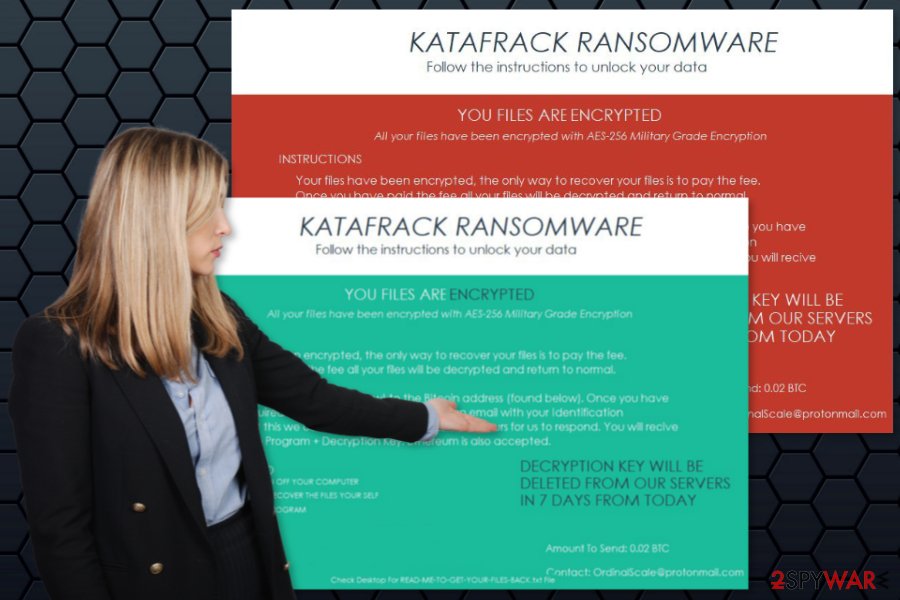Katafrack ransomware / virus (Easy Removal Guide) - Quick Decryption Solution
Katafrack virus Removal Guide
What is Katafrack ransomware virus?
Katafrack threatens users into paying the ransom

Katafrack is an updated[1] variant of Ordinal ransomware. Malware is based on HiddenTear open source project and uses AES-256 cryptography to corrupt files on the targeted system. Once the destructive task is over, crypto-virus provides data recovery instructions in the “READ-ME-the TO-the GET-YOUR-FILES-BACK.txt” file.
The text file includes a short message about the unpleasant situation and informs what victims have to transfer 0.02 Bitcoins and send unique ID number to OrdinalScale@protonmail.com email address:
Your files is have Been encrypted by ransomware Ordinal
Below is the information you will of your Up Need to decrypt the files is
of After That, you'll the BE Able to see your beloved files is again.
Email: OrdinalScale@protonmail.com
The BTC the Address: [xxx]
the ETH the Address [xxx]
the Amount of Post Send the To: 0.02 The BTC
Identification: [xxx]
Additionally, Katafrack virus delivers one of two lock-screen messages. Ransomware might shoe either green or red windows with identical information. Crooks promise to respond within 12-24 hours and send decryption program with a specific key which is said to be deleted within 7 days since the attack. However, security experts warn that it might never happen.
There are numerous cases when ransomware developers did not keep their word and left people without encrypted files. Therefore, victims of the Katafrack ransomware are suggested remain calm and do not pay attention to crooks’ threats.
Even though they tell not to remove Katafrack from the system or try alternative recovery methods, that’s exactly what you should do. The virus makes critical changes to the system and makes it vulnerable. Thus, you won’t be able to use the computer without criminals breathing behind your back.
Therefore, we highly recommend terminating this malicious program from the device using FortectIntego or another anti-malware program. Please do not try to perform manual Katafrack removal because it is most likely to end up with a damaged system. Ransomware injects malicious code into legit processes and might modify Registry, so only reputable tools can clean the PC without damaging it.

Things to know about ransomware distribution
The file-encrypting virus spreads via malicious spam emails and their attachments,[2] malicious ads, fake updates and downloads. Thus, you should watch out your downloads and clicks. Before making a move, always make sure that content is safe.
Additionally, ransomware can take advantage of weak RDP configuration, outdated software and unpatched systems. Thus, using up-to-date programs and keeping antivirus installed should minimize the risk of the cyber attack.
However, security experts from Bedynet.ru[3] warn that crypto-viruses are sneaky and might manage to find a way to users’ computers. Thus, keeping backups is a must to prevent important data loss.
Removal of the Katafrack malware
As we have mentioned before, you should not try to locate and terminate ransomware-related entries from the computer. It’s a complicated cyber threat that should be treated properly. For this reason, you have to remove Katafrack with a security program, for instance, FortectIntego or Malwarebytes.
However, malware might be designed to block antivirus activity. Thus, you should disable the virus first. The guide below will show you two methods how to do it and run automatic Katafrack removal successfully. Additionally, you will find data recovery suggestions that might help to get back some of the files.
Getting rid of Katafrack virus. Follow these steps
Manual removal using Safe Mode
It's one of the methods that help to disable the virus in order to run automatic elimination:
Important! →
Manual removal guide might be too complicated for regular computer users. It requires advanced IT knowledge to be performed correctly (if vital system files are removed or damaged, it might result in full Windows compromise), and it also might take hours to complete. Therefore, we highly advise using the automatic method provided above instead.
Step 1. Access Safe Mode with Networking
Manual malware removal should be best performed in the Safe Mode environment.
Windows 7 / Vista / XP
- Click Start > Shutdown > Restart > OK.
- When your computer becomes active, start pressing F8 button (if that does not work, try F2, F12, Del, etc. – it all depends on your motherboard model) multiple times until you see the Advanced Boot Options window.
- Select Safe Mode with Networking from the list.

Windows 10 / Windows 8
- Right-click on Start button and select Settings.

- Scroll down to pick Update & Security.

- On the left side of the window, pick Recovery.
- Now scroll down to find Advanced Startup section.
- Click Restart now.

- Select Troubleshoot.

- Go to Advanced options.

- Select Startup Settings.

- Press Restart.
- Now press 5 or click 5) Enable Safe Mode with Networking.

Step 2. Shut down suspicious processes
Windows Task Manager is a useful tool that shows all the processes running in the background. If malware is running a process, you need to shut it down:
- Press Ctrl + Shift + Esc on your keyboard to open Windows Task Manager.
- Click on More details.

- Scroll down to Background processes section, and look for anything suspicious.
- Right-click and select Open file location.

- Go back to the process, right-click and pick End Task.

- Delete the contents of the malicious folder.
Step 3. Check program Startup
- Press Ctrl + Shift + Esc on your keyboard to open Windows Task Manager.
- Go to Startup tab.
- Right-click on the suspicious program and pick Disable.

Step 4. Delete virus files
Malware-related files can be found in various places within your computer. Here are instructions that could help you find them:
- Type in Disk Cleanup in Windows search and press Enter.

- Select the drive you want to clean (C: is your main drive by default and is likely to be the one that has malicious files in).
- Scroll through the Files to delete list and select the following:
Temporary Internet Files
Downloads
Recycle Bin
Temporary files - Pick Clean up system files.

- You can also look for other malicious files hidden in the following folders (type these entries in Windows Search and press Enter):
%AppData%
%LocalAppData%
%ProgramData%
%WinDir%
After you are finished, reboot the PC in normal mode.
Remove Katafrack using System Restore
If the previous method did not work, please try the second one:
-
Step 1: Reboot your computer to Safe Mode with Command Prompt
Windows 7 / Vista / XP- Click Start → Shutdown → Restart → OK.
- When your computer becomes active, start pressing F8 multiple times until you see the Advanced Boot Options window.
-
Select Command Prompt from the list

Windows 10 / Windows 8- Press the Power button at the Windows login screen. Now press and hold Shift, which is on your keyboard, and click Restart..
- Now select Troubleshoot → Advanced options → Startup Settings and finally press Restart.
-
Once your computer becomes active, select Enable Safe Mode with Command Prompt in Startup Settings window.

-
Step 2: Restore your system files and settings
-
Once the Command Prompt window shows up, enter cd restore and click Enter.

-
Now type rstrui.exe and press Enter again..

-
When a new window shows up, click Next and select your restore point that is prior the infiltration of Katafrack. After doing that, click Next.


-
Now click Yes to start system restore.

-
Once the Command Prompt window shows up, enter cd restore and click Enter.
Bonus: Recover your data
Guide which is presented above is supposed to help you remove Katafrack from your computer. To recover your encrypted files, we recommend using a detailed guide prepared by 2-spyware.com security experts.If your files are encrypted by Katafrack, you can use several methods to restore them:
Data Recovery Pro might help to restore files
This tool is created for helping people to recover corrupted or deleted files. However, sometimes it helps to restore files after the ransomware attack.
- Download Data Recovery Pro;
- Follow the steps of Data Recovery Setup and install the program on your computer;
- Launch it and scan your computer for files encrypted by Katafrack ransomware;
- Restore them.
Acces the most important files with Windows Previous Versions feature
This Windows feature allows accessing files before Katafrack attack. However, system restore had to be enabled before the attack.
- Find an encrypted file you need to restore and right-click on it;
- Select “Properties” and go to “Previous versions” tab;
- Here, check each of available copies of the file in “Folder versions”. You should select the version you want to recover and click “Restore”.
ShadowExplorer can help to restore files from Shadow Volume Copies
If you are lucky enough and ransomware did not delete Shadow Volume Copies, this tool can help you a lot:
- Download Shadow Explorer (http://shadowexplorer.com/);
- Follow a Shadow Explorer Setup Wizard and install this application on your computer;
- Launch the program and go through the drop down menu on the top left corner to select the disk of your encrypted data. Check what folders are there;
- Right-click on the folder you want to restore and select “Export”. You can also select where you want it to be stored.
Katafrack decryptor is not available yet
However, the virus is based on HiddenTear, so you can try its decryptors as well: Decrypter No 1 and Decrypter No 2.
Finally, you should always think about the protection of crypto-ransomwares. In order to protect your computer from Katafrack and other ransomwares, use a reputable anti-spyware, such as FortectIntego, SpyHunter 5Combo Cleaner or Malwarebytes
How to prevent from getting ransomware
Choose a proper web browser and improve your safety with a VPN tool
Online spying has got momentum in recent years and people are getting more and more interested in how to protect their privacy online. One of the basic means to add a layer of security – choose the most private and secure web browser. Although web browsers can't grant full privacy protection and security, some of them are much better at sandboxing, HTTPS upgrading, active content blocking, tracking blocking, phishing protection, and similar privacy-oriented features. However, if you want true anonymity, we suggest you employ a powerful Private Internet Access VPN – it can encrypt all the traffic that comes and goes out of your computer, preventing tracking completely.
Lost your files? Use data recovery software
While some files located on any computer are replaceable or useless, others can be extremely valuable. Family photos, work documents, school projects – these are types of files that we don't want to lose. Unfortunately, there are many ways how unexpected data loss can occur: power cuts, Blue Screen of Death errors, hardware failures, crypto-malware attack, or even accidental deletion.
To ensure that all the files remain intact, you should prepare regular data backups. You can choose cloud-based or physical copies you could restore from later in case of a disaster. If your backups were lost as well or you never bothered to prepare any, Data Recovery Pro can be your only hope to retrieve your invaluable files.
- ^ Marc Laliberte. Why hackers reuse malware. Help Net Security. Daily information security news with a focus on enterprise security.
- ^ Patrick Allan. Ransomware Is Being Hidden Inside Attachments of Attachments. Lifehacker. Tips, tricks and downloads for getting things done.
- ^ Bedynet. Bedynet. Security news and malware database.





















